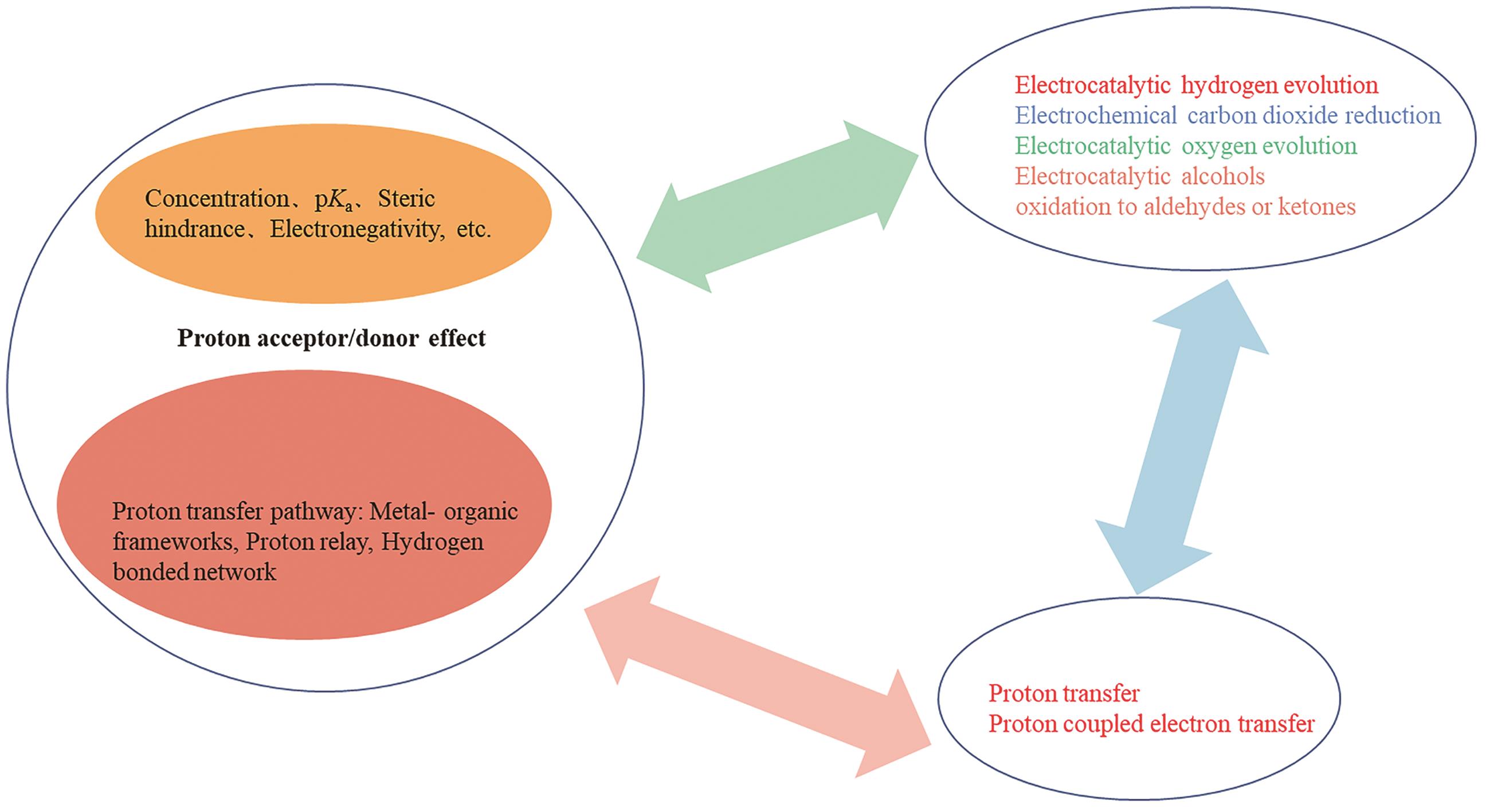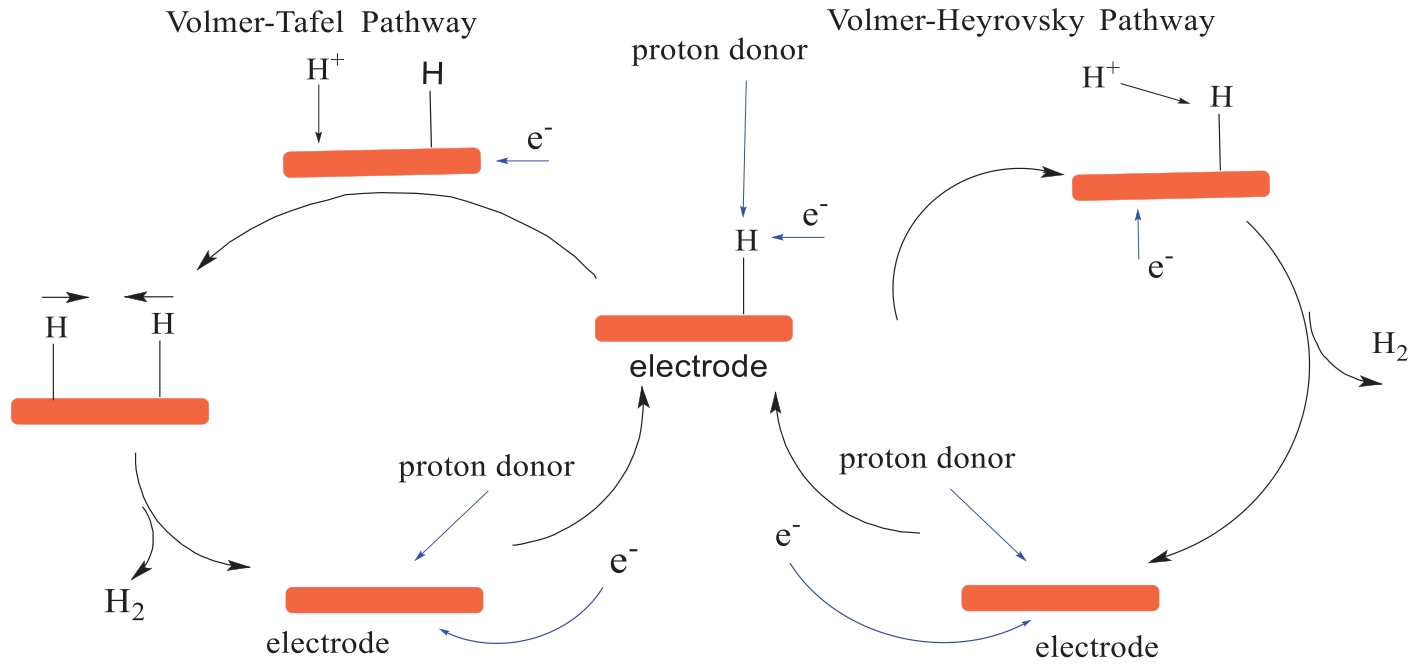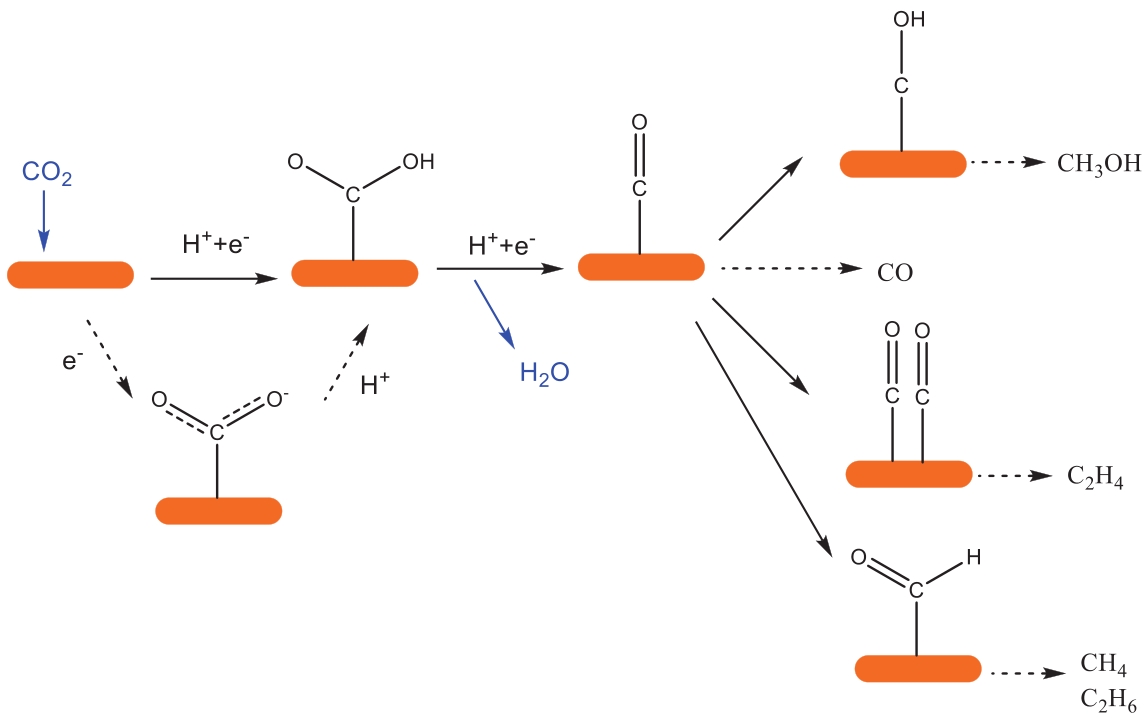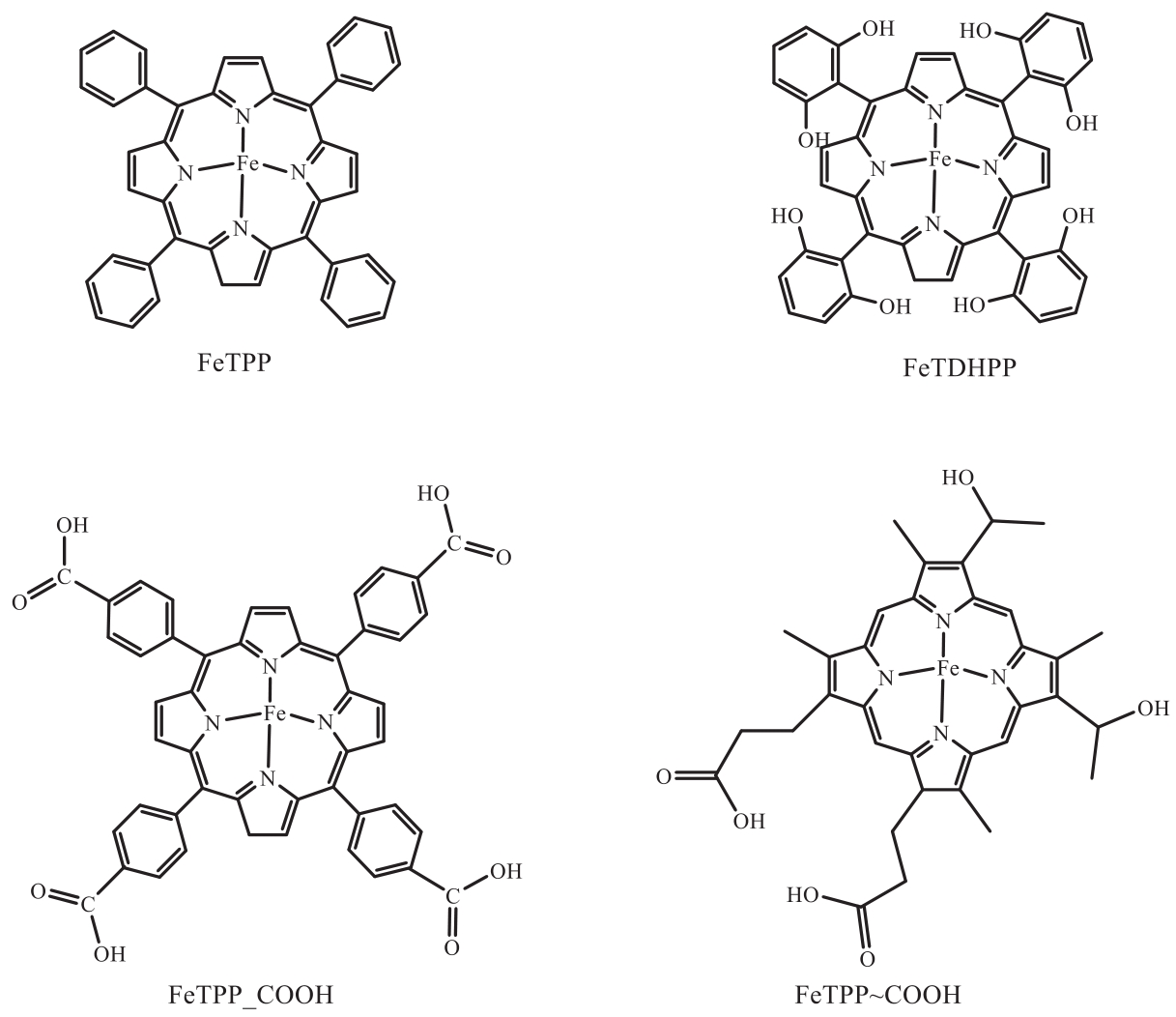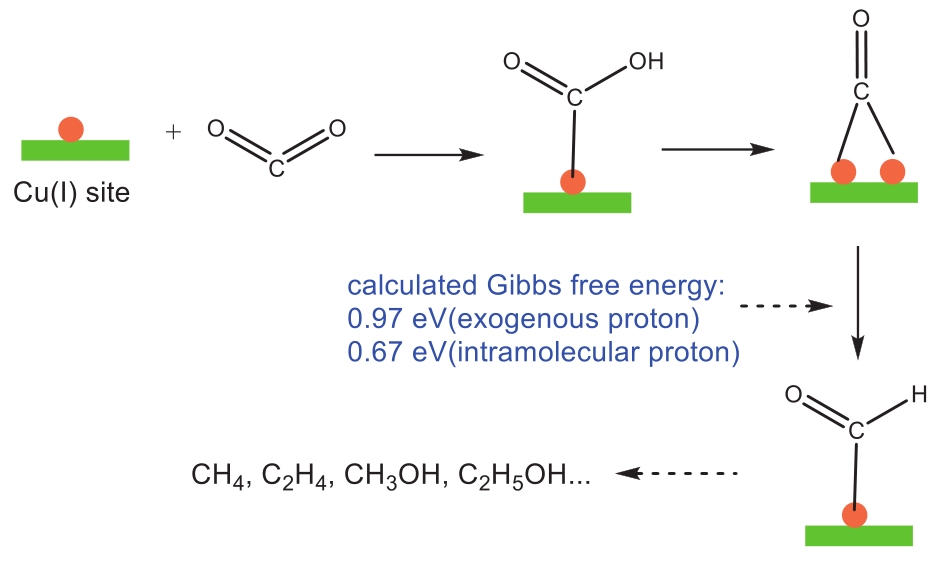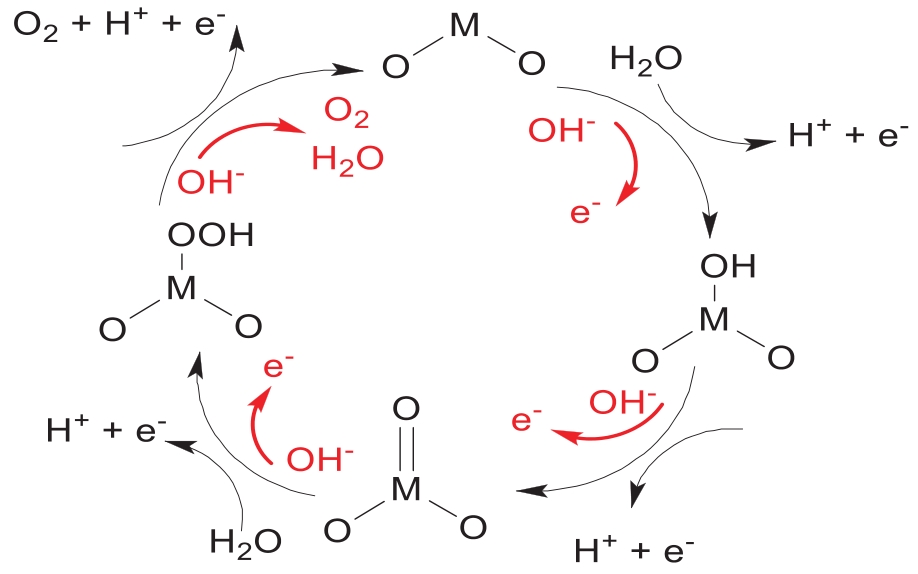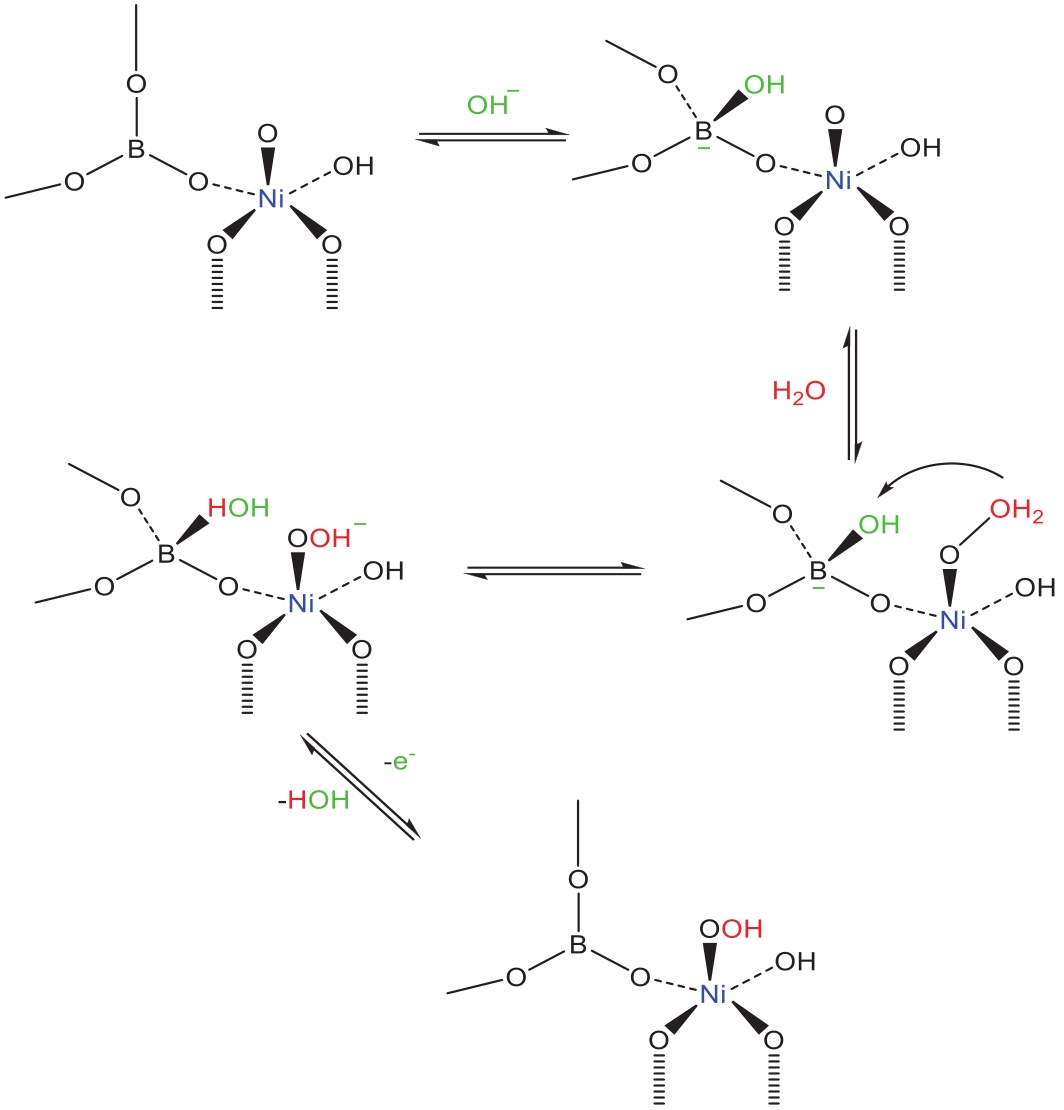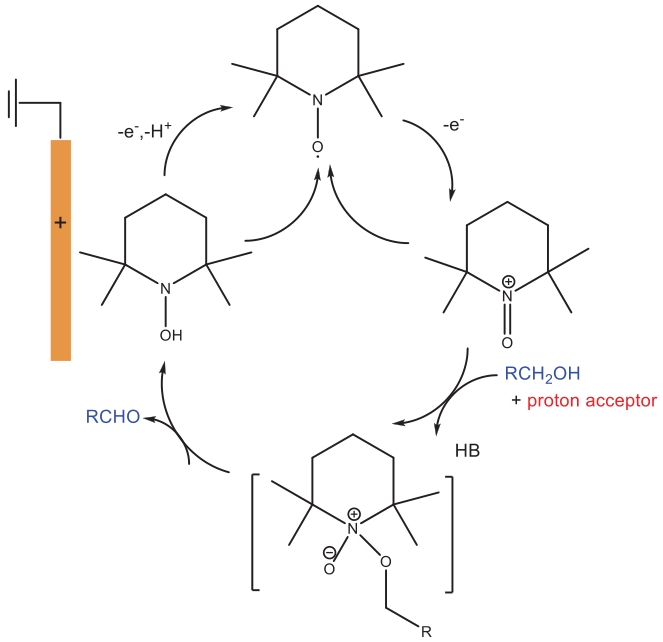
应用化学 ›› 2023, Vol. 40 ›› Issue (5): 666-680.DOI: 10.19894/j.issn.1000-0518.220316
质子给受体对电催化反应影响的研究进展
- 1.宜春学院化学与生物工程学院,宜春 336000
2.江西省高等学校应用化学与化学生物学重点实验室,宜春 336000
-
收稿日期:2022-09-27接受日期:2023-02-18出版日期:2023-05-01发布日期:2023-05-26 -
通讯作者:张文彬 -
基金资助:国家自然科学基金(21962019)
Research Progress in the Effects of Proton Acceptor/Donor on Electrocatalytic Reactions
Feng ZHU1,2, Xiao-Lian PENG1, Wen-Bin ZHANG1,2( )
)
- 1.College of Chemistry and Bio-engineering,Yichun University,Yichun 336000,China
2.Key Laboratory of Jiangxi University of Applied Chemistry and Chemical Biology,Yichun 336000,China
-
Received:2022-09-27Accepted:2023-02-18Published:2023-05-01Online:2023-05-26 -
Contact:Wen-Bin ZHANG -
About author:zhangwbycu@163.com
-
Supported by:the National Natural Science Foundation of China(21962019)
摘要:
质子给受体是众多电催化反应中重要的参与者,质子给受体种类和浓度对电催化反应速率甚至产物种类均会有显著影响。本文从电催化析氢、二氧化碳的电化学还原、电催化析氧及醇的电化学氧化生成醛酮的典型反应机理出发,总结这4种电催化反应中所用质子给受体种类及质子转移路径等,探讨它们对电催化反应效率的影响。
中图分类号:
引用本文
朱凤, 彭小连, 张文彬. 质子给受体对电催化反应影响的研究进展[J]. 应用化学, 2023, 40(5): 666-680.
Feng ZHU, Xiao-Lian PENG, Wen-Bin ZHANG. Research Progress in the Effects of Proton Acceptor/Donor on Electrocatalytic Reactions[J]. Chinese Journal of Applied Chemistry, 2023, 40(5): 666-680.
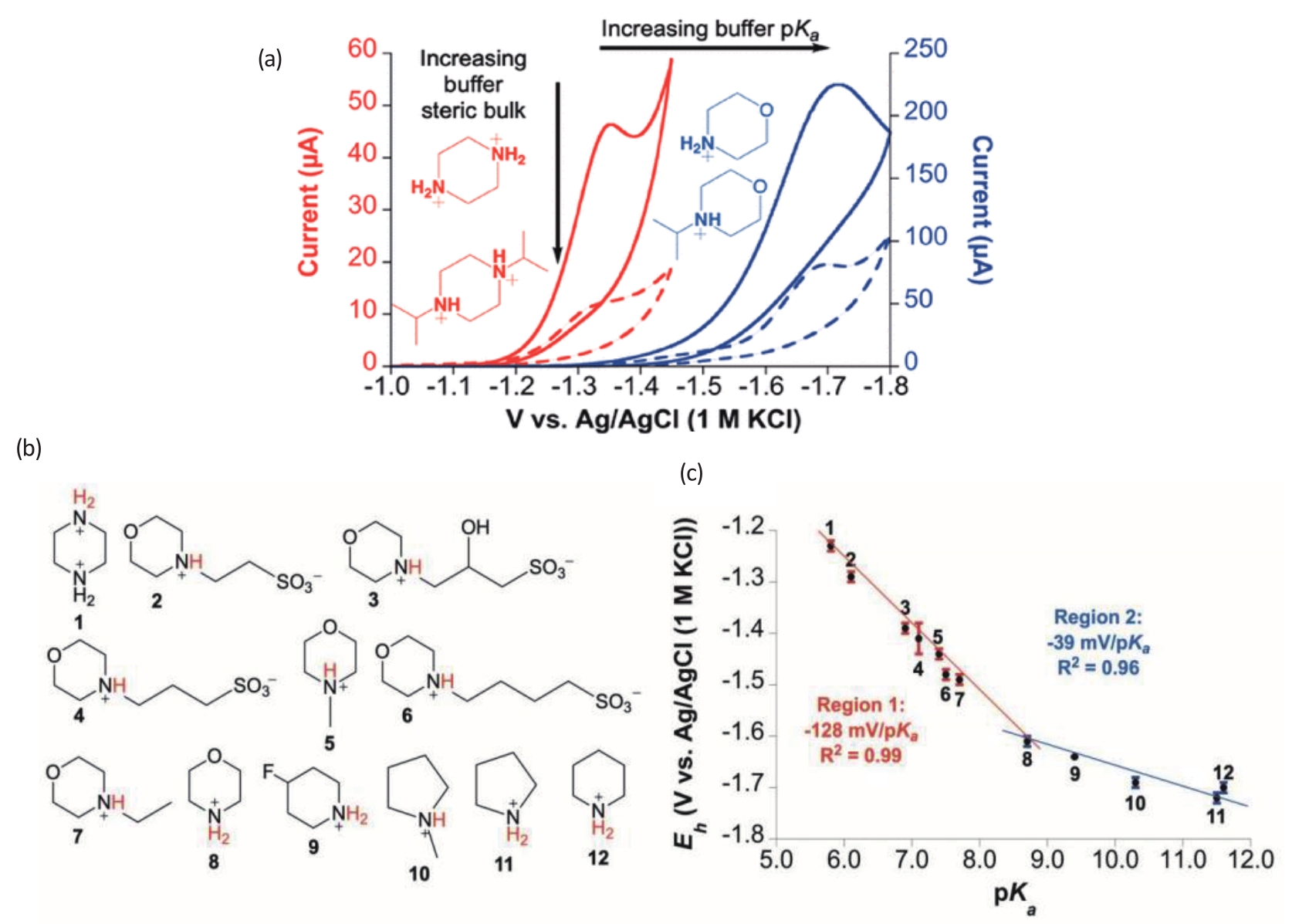
图3 (a) 不同缓冲组分加入时的析氢循环伏安图,测量体系:1.0 μmol/L CoMC6*a,50 mmol/L缓冲物,100 mmol/L氯化钾水溶液,pH值为6.5,玻碳电极为辅助电极,Ag/AgCl (1 mol/L KCl)为参比电极,悬汞电极为工作电极; (b) 不同缓冲组分结构; (c) 缓冲物pKa值与催化电位关系图,区域1斜率为-128 mV/pKa(pKa:1~8),区域2斜率为-39 mV/pKa(pKa:8~12)[15]
Fig.3 (a) Cyclic voltammograms for hydrogen evolution with the addition of different buffer species, measurement system: 1.0 μmol/L CoMC6*a, 50 mmol/L of the buffer, 100 mmol/L KCl, and a pH of 6.5, A glassy carbon counter electrode, Ag/AgCl (1 mol/L KCl) reference electrode, and hanging drop mercury electrode; (b) Molecular structure of different buffer species; (c) A plot of catalytic potential values as a function of buffer acid pKa, Region 1 has a slope of -128 mV/pKa unit (pKa: 1~8), and region 2 has a slope of -39 mV/pKa unit (pKa: 8~12)[15]

图4 多晶金电极在乙腈溶液中电解液中,质子给体空间位阻影响示意图[16]
Fig.4 Schematic of steric effect in electrochemical hydrogen evolution at polycrystalline gold electrode in acetonitrile electrolyte[16]
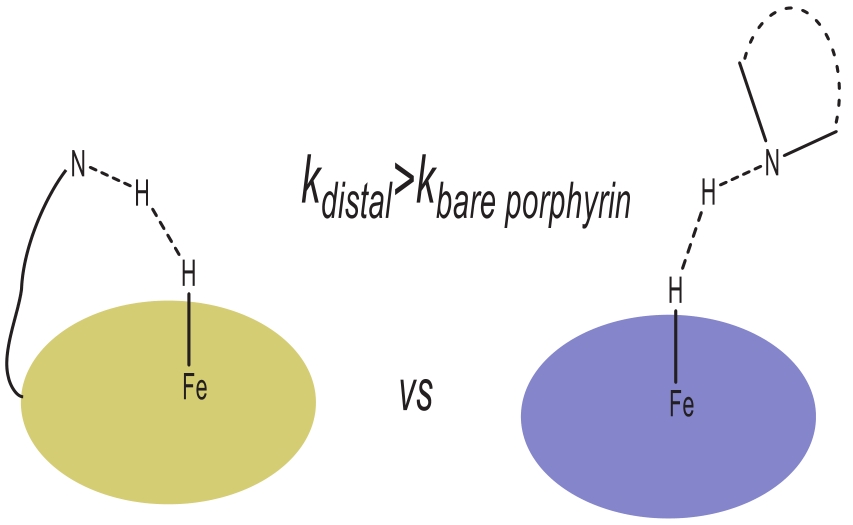
图5 铁卟啉用于电化学析氢时不同质子来源(分子内或分子间)比较示意图[25]
Fig.5 Schematic view of proton sources (intermolecular or intramolecular) comparison in electrochemical hydrogen evolution for iron porphyrin catalyst[25]
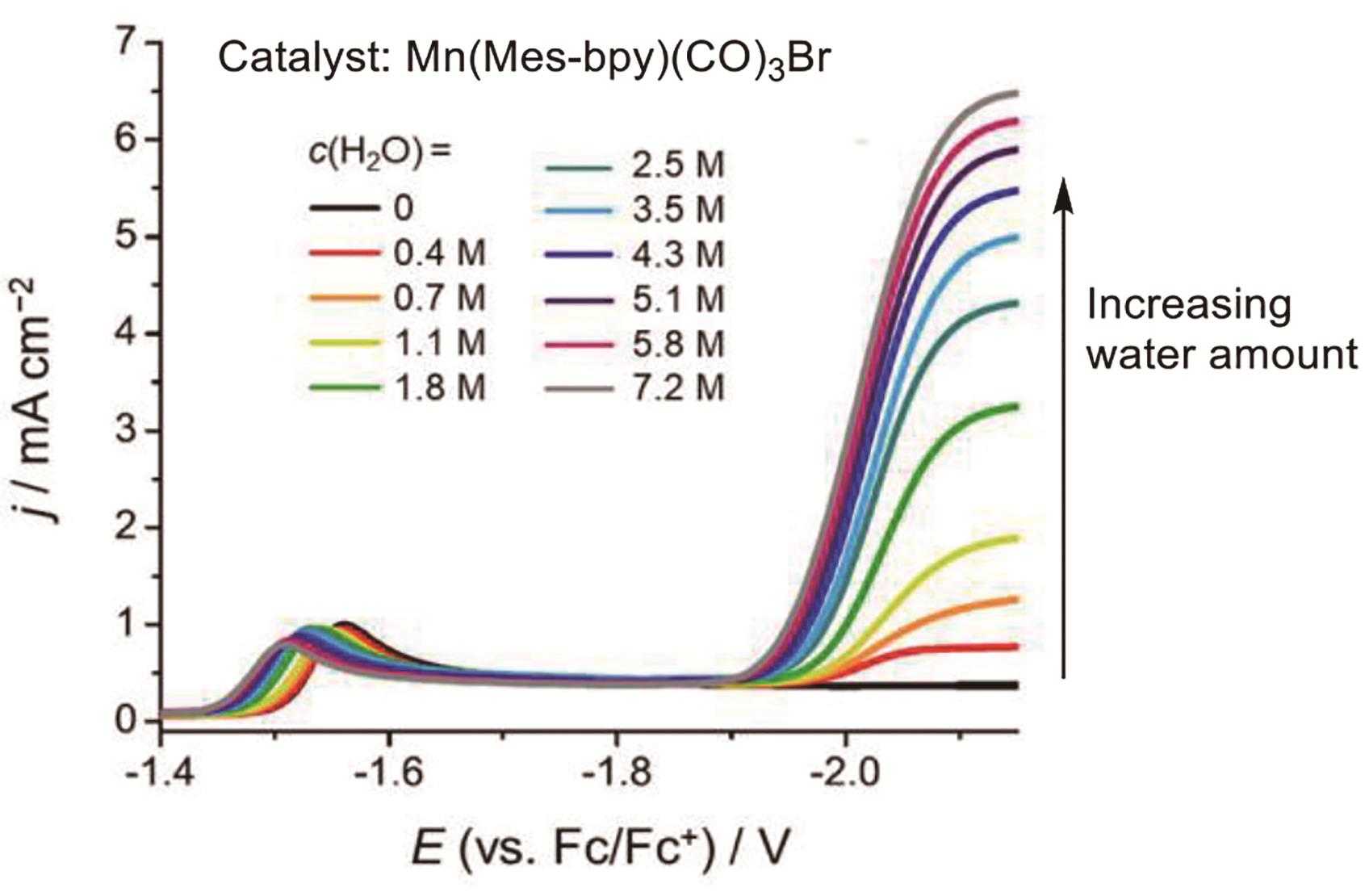
图8 饱和二氧化碳的含0.1 mol/L NBu4PF6的乙腈电解液中,外加不同浓度水的[Mn(Mes-bpy)(CO)3Br]线性扫描曲线[33]
Fig.8 Linear scans of[Mn(Mes-bpy)(CO)3Br] under saturated CO2 atmosphere in CH3CN with 0.1 mol/L NBu4PF6 with various amounts of added H2O[33]

图10 Re吡啶配合物电化学还原二氧化碳过程中酚羟基质子中继作用示意图[40]
Fig.10 Schematic view of the phenol group-based proton relay in electrocatalytic CO2 reduction with Re-bipyridine complexes[40]

图14 金属氧化物电催化析氧过程中的质子耦合电子转移分步机理及协同机理[57-58]
Fig.14 Step mechanism and concerted mechanism of proton coupled electron transfer during metal oxide mediated oxygen evolution[57-58]

图15 (a)具有经典质子受体; (b)具有分子层面质子受体钙钛矿型氧化物催化剂析氧机理示意图[65-66]
Fig.15 Schematic diagram of oxygen evolution mechanism of perovskite oxide type catalyst with (a) a traditional proton acceptor and (b) a molecular-level proton acceptor[65-66]
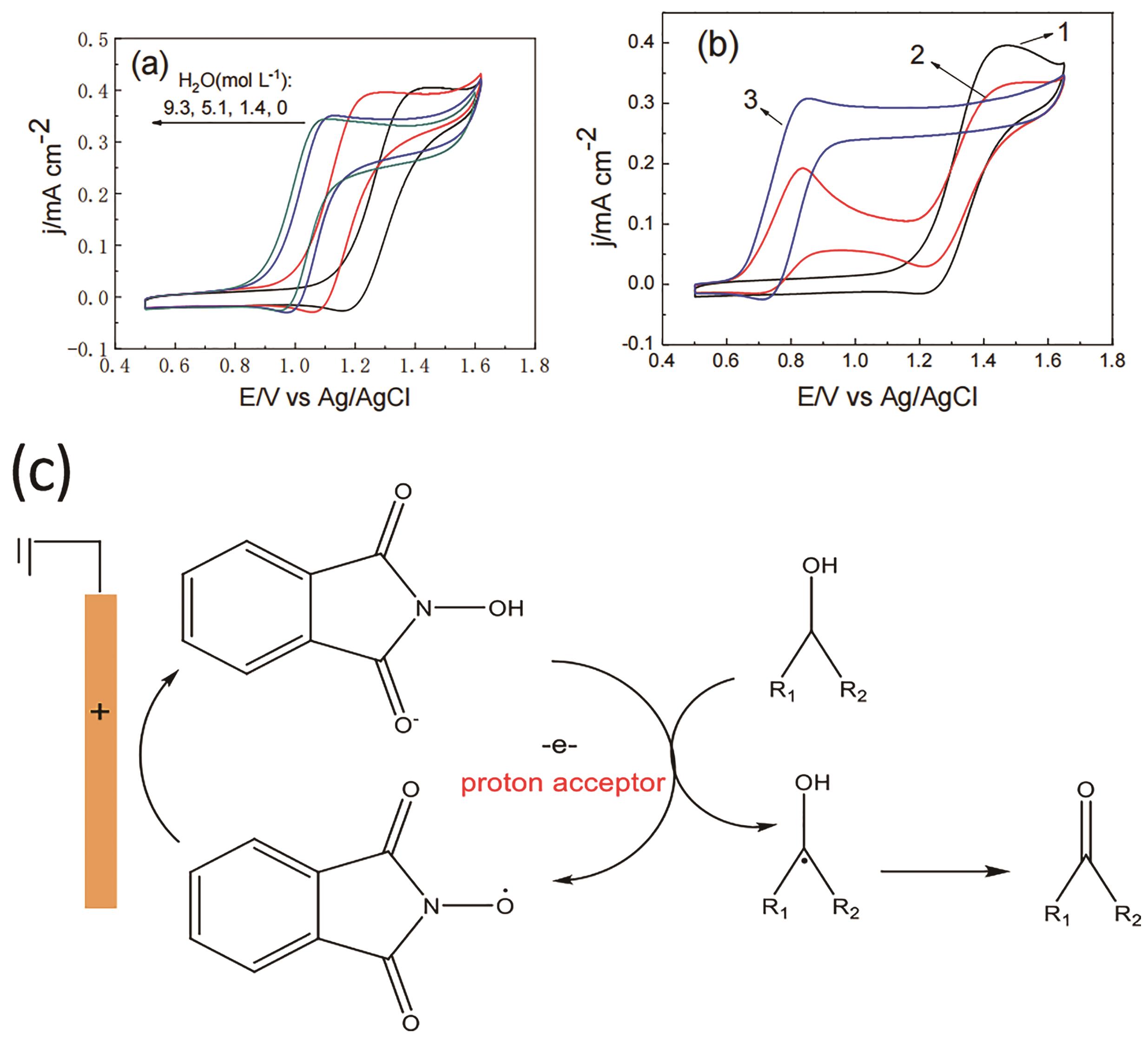
图17 在10.0 mmol/L苯甲醇存在下,2.0 mmol/L NHPI的循环伏安图: (a)不同浓度水, (b)不同浓度2,6二甲基吡啶; (c) NHPI电催化氧化醇的可能机理[72]
Fig.17 (a) CVs of 2.0 mmol/L NHPI in the presence of 10.0 mmol /L benzyl alcohol (a) with the addition of different amounts of water, (b) in the presence of different concentration of 2,6-lutidine, (c) suggested mechanism of NHPI-mediated electrooxidation of alcohols[72]
| 1 | HOLADE Y, SERVAT K, TINGRY S. Advances in electrocatalysis for energy conversion and synthesis of organic molecules[J]. ChemPhysChem, 2017, 18: 2573-2605. |
| 2 | AKHADE S A, SINGH N, GUTIERREZ O Y, et al. Electrocatalytic hydrogenation of biomass-derived organics: a review[J]. Chem Rev, 2020, 120(20): 11370-11419. |
| 3 | HOLADE Y, TULEUSHOVA N, TINGRY S, et al. Recent advances in the electrooxidation of biomass-based organic molecules for energy, chemicals and hydrogen production[J]. Catal Sci Tech, 2020, 10(10): 3071-3112. |
| 4 | CHENG W, SUN L, HE X, et al. Recent advances in fuel cell reaction electrocatalysis based on porous noble metal nanocatalysts[J]. Dalton Trans, 2022, 51: 7763-7774. |
| 5 | LIU Y, LIANG X, GU L, et al. Corrosion engineering towards efficient oxygen evolution electrodes with stable catalytic activity for over 6000 hours[J]. Nat Commun, 2018, 9: 2609. |
| 6 | DATTILA F, SEEMAKURTHI R R, ZHOU Y. Modeling operando electrochemical CO2 reduction[J]. Chem Rev, 2022, 122(12): 11085-11130. |
| 7 | WARBURTON R E, SOUDACKOV A V, HAMMES-SCHIFFER S. Theoretical modeling of electrochemical proton-coupled electron transfer[J]. Chem Rev, 2022, 122(12): 10599-10650. |
| 8 | AGARWAL R G, COSTE S C, GROFF B D, et al. Free energies of proton-coupled electron transfer reagents and their applications[J]. Chem Rev, 2022, 122(1): 1-49. |
| 9 | ZHANG X, LI Y, GUO P. Theory on optimizing the activity of electrocatalytic proton coupled electron transfer reactions[J]. J Catal, 2019, 376: 17-24. |
| 10 | 孙世刚. 电催化纳米材料[M]. 北京: 化学工业出版社, 2018. |
| SUN S G. Nanostructured electrocatalysts[M]. Beijing: Chemical Industry Press, 2018. | |
| 11 | ZHANG X, LI Y, GUO P, et al. Theory on optimizing the activity of electrocatalytic proton coupled electron transfer reactions[J]. J Catal, 2019, 376: 17-24. |
| 12 | ZHU J, HU L, ZHAO P, et al. Recent advances in electrocatalytic hydrogen evolution using nanoparticles[J]. Chem Rev, 2019, 120(2): 851-918. |
| 13 | LAMOUREUX P S, SINGH A R, CHAN K. pH effects on hydrogen evolution and oxidation over Pt(111): insights from first-principles[J]. ACS Catal, 2019, 9(7): 6194-6201. |
| 14 | ALVAREZ-HERNANDEZ J, SOPCHAK A, BREN K. Buffer pKa impacts the mechanism of hydrogen evolution catalyzed by a cobalt porphyrin-peptide[J]. Inorg Chem, 2020, 59(12): 8061-8069. |
| 15 | LE J, ALACHOUZOS G, FRONTIER A, et al. Tuning mechanism through buffer dependence of hydrogen evolution catalyzed by a cobalt mini-enzyme[J]. Biochemistry, 2020, 59(12): 1289-1297. |
| 16 | JACKSON M N, SURENDRANATH Y. Donor-dependent kinetics of interfacial proton-coupled electron transfer[J]. J Am Chem Soc, 2016, 138(9): 3228-3234. |
| 17 | CLARY K E, KARAYILAN M, MCCLEARY-PETERSEN K C, et al. Increasing the rate of the hydrogen evolution reaction in neutral water with protic buffer electrolytes[J]. Proc Nat Acad Sci USA, 2020(52): 3737-3743. |
| 18 | JACKSON M N, JUNG O, LAMOTTE H C, et al. Donor-dependent promotion of interfacial proton-coupled electron transfer in aqueous electrocatalysis[J]. ACS Catal, 2019, 9(4): 3737-3743. |
| 19 | HOD I, DERIA P, BURY W, et al. A porous proton-relaying metal-organic framework material that accelerates electrochemical hydrogen evolution[J]. Nat Commun, 2015, 6: 8304. |
| 20 | DOLUI D, GHORAI S, DUTTA A. Tuning the reactivity of cobalt-based H2 production electrocatalysts via the incorporation of the peripheral basic functionalities[J]. Coordin Chem Rev, 2020, 416: 213335. |
| 21 | 刘涛, 张清鑫, 郭鸿波, 等. 金属卟啉类化合物在电催化氧还原反应的应用[J]. 中国科学: 化学, 2022, 52(8): 1306-1320. |
| LIU T, ZHANG Q X, GUO H B, et al. Electrocatalytic oxygen reduction reaction with metalloporphyrins[J]. Sci China-Chem, 2022, 52(8): 1306-1320. | |
| 22 | WIEDNER E S, APPEL A M, RAUGEI S, et al. Molecular catalysts with diphosphine ligands containing pendant amines[J]. Chem Rev, 2022, 122(14): 12427-12474. |
| 23 | ROUBELAKIS M M, BEDIAKO D K, DOGUTAN D K, et al. Proton-coupled electron transfer kinetics for the hydrogen evolution reaction of hangman porphyrins[J]. Energy Environ Sci, 2012, 5: 7737-7740. |
| 24 | THAMMAVONGSY Z, MERCER I P, YANG J Y. Promoting proton coupled electron transfer in redox catalysts through molecular design[J]. Chem Commun, 2019, 55(70): 10342-10358. |
| 25 | BHUNIA S, RANA A, HEMATIAN S, et al. Proton relay in iron porphyrins for hydrogen evolution reaction[J]. Inorg Chem, 2021, 60(18): 13876-13887. |
| 26 | LI X L, LV B, ZHANG X P, et al. Introducing water-network-assisted proton transfer for boosted electrocatalytic hydrogen evolution with cobalt corrole[J]. Angew Chem Int Ed, 2022, 61(9): 202114310. |
| 27 | FRANCKE R, SCHILLE B, ROEMELT M, et al. Homogeneously catalyzed electroreduction of carbon dioxide-methods, mechanisms, and catalysts[J]. Chem Rev, 2018, 118(9): 4631-4701. |
| 28 | ZHANG R, WU B, LI Q, et al. Design strategies and mechanism studies of CO2 electroreduction catalysts based on coordination chemistry[J]. Coord Chem Rev, 2020, 422: 213436. |
| 29 | ANGAMUTHU R, BYERS P, LUTZ M, et al. Electrocatalytic CO2 conversion to oxalate by a copper complex[J]. Science, 2010, 327(5963): 313-315. |
| 30 | CHU A T, SURENDRANATH Y. Aprotic solvent exposes an altered mechanism for copper-catalyzed ethylene electrosynthesis[J]. J Am Chem Soc, 2022, 144(12): 5359-5365. |
| 31 | RUDNEV A V, ZHUMAEV U E, KUZUME A, et al. The promoting effect of water on the electroreduction of CO2 in acetonitrile[J]. Electrochim Acta, 2016, 189: 38-44. |
| 32 | FIGUEIREDO M C, LEDEZMA-YANEZ I, KOPER M. In situ spectroscopic study of CO2 electroreduction at copper electrodes in acetonitrile[J]. ACS Catal, 2016, 6(4): 2382-2392. |
| 33 | SAMPSON M D, NGUYEN A D, GRICE K A. et al. Manganese catalysts with bulky bipyridine ligands for the electrocatalytic reduction of carbon dioxide: eliminating dimerization and altering catalysis[J]. J Am Chem Soc, 2014, 136(14): 5460-5471. |
| 34 | BHUGUN I, LEXA D, SAVÉANT J M, et al. Catalysis of the electrochemical reduction of carbon dioxide by iron(0) porphyrins. synergistic effect of lewis acid cations[J]. J Phys Chem B, 1996, 100(51): 19981-19985. |
| 35 | COSTENTIN C, DROUET S, ROBERT M, et al. A local proton source enhances CO2 electroreduction to CO by a molecular Fe catalyst[J]. Science, 2012, 338(6103): 90-94. |
| 36 | ZHOU Y, XIAO Y, ZHAO J. A local proton source from carboxylic acid functionalized metal porphyrins for enhanced electrocatalytic CO2 reduction[J]. New J Chem, 2020, 44: 16062-16068. |
| 37 | ZHAO Y J, ZHENG L L, JIANG D, et al. Nanoengineering metal-organic framework-based materials for use in electrochemical CO2 reduction reactions[J]. Small, 2021, 17(16): 2006590. |
| 38 | HUI S R, LUNA P D. How increasing proton and electron conduction benefits electrocatalytic CO2 reduction[J]. Matter, 2021, 4(5): 1555-1577. |
| 39 | NICHOLS A W, HOOE S L, KUEHNER J S, et al. Electrocatalytic CO2 reduction to formate with molecular Fe(III) complexes containing pendent proton relays[J]. Inorg Chem, 2020, 59(9): 5854-5864. |
| 40 | YANG Y, ZHANG Z Y, ZHANG Z Y, et al. Electrocatalytic CO2 reduction with Re-based spiro bipyridine complexes: effects of the local proton in the second coordination sphere[J]. Chin J Chem, 2021, 39(5): 1281-1287. |
| 41 | CHAPOVETSKY A, WELBORN M, LUNA J M, et al. Pendant hydrogen-bond donors in cobalt catalysts independently enhance CO 2 reduction[J]. ACS Central Sci, 2018, 4(3): 397-404. |
| 42 | DERRICK J S, LOIPERSBERGER M, NISTANAKI S K, et al. Templating bicarbonate in the second coordination sphere enhances electrochemical CO2 reduction catalyzed by iron porphyrins[J]. J Am Chem Soc, 2022, 144(26): 11656-11663. |
| 43 | SIEWERT I. Electrochemical CO2 reduction catalyzed by binuclear LRe2(CO)6Cl2 and LMn2(CO)6Br2 complexes with an internal proton source[J]. Acc Chem Res, 2022, 55(4): 473-483. |
| 44 | WILTING A, STOLPER T, MATA R A, et al. Dinuclear rhenium complex with a proton responsive ligand as a redox catalyst for the electrochemical CO2 reduction[J]. Inorg Chem, 2017, 56(7): 4176-4185. |
| 45 | FOKIN I, DENISIUK A, WÜRTELE C, et al. The impact of a proton relay in binuclear α-diimine-Mn(CO)3 complexes on the CO2 reduction catalysis[J]. Inorg Chem, 2019, 58(16): 10444-10453. |
| 46 | ZHU H L, CHEN H Y, HAN Y X, et al. A porous π-π stacking framework with dicopper(I) sites and adjacent proton relays for electroreduction of CO2 to C2+ products[J]. J Am Chem Soc, 2022, 144(29): 13319-13326. |
| 47 | MIYAMOTO K, ASAHI R. Water facilitated electrochemical reduction of CO2 on cobalt-porphyrin catalysts[J]. J Phys Chem C, 2019, 123(15): 9944-9948. |
| 48 | BLAKEMORE J D, CRABTREE R H, BRUDVIG G W. Molecular catalysts for water oxidation[J]. Chem Rev, 2015, 115(23): 12974-13005. |
| 49 | MAN I C, SU H Y, CALLE-VALLEJO F, et al. Universality in oxygen evolution electro-catalysis on oxide surfaces[J]. ChemCatChem, 2011, 3(7): 1159-1165. |
| 50 | GIORDANO L, HAN B, RISCH M, et al. pH dependence of OER activity of oxides: current and future perspectives[J]. Catal Today, 2016, 262(15): 2-10. |
| 51 | COGGINS M K, ZHANG M, CHEN Z, et al. Single-site copper(II) water oxidation electrocatalysis: rate enhancements with HPO 4 2 - as a proton acceptor at pH 8[J]. Angew Chem Int Ed, 2014, 53(45): 12226-12230. |
| 52 | ZHANG Z, ZHANG T, LEE J Y. The enhancement effect of borate doping on the oxygen evolution activity of α-nickel hydroxide[J]. ACS Appl Nano Mater, 2018, 1(2): 751-758 |
| 53 | MAVROS M G, TSUCHIMOCHI T, KOWALCZYK T, et al. What can density functional theory tell us about artificial catalytic water splitting?[J]. Inorg Chem, 2014, 53(13): 6386-6397. |
| 54 | GERKEN J B, MCALPIN J G, CHEN J Y C, et al. Electrochemical water oxidation with cobalt-based electrocatalysts from pH 0~14: the thermodynamic basis for catalyst structure, stability, and activity[J]. J Am Chem Soc, 2011, 133(36): 14431-14442. |
| 55 | SURENDRANATH Y, KANAN M W, NOCERA D G. Mechanistic studies of the oxygen evolution reaction by a cobalt-phosphate catalyst at neutral pH[J]. J Am Chem Soc, 2010, 132(46): 16501-16509. |
| 56 | BEDIAKO D K, SURENDRANATH Y, NOCERA D G. Mechanistic studies of the oxygen evolution reaction mediated by a nickel-borate thin film electrocatalyst[J]. J Am Chem Soc, 2013, 135(9): 3662-3674. |
| 57 | YAMAGUCHI A, INUZUKA R, TAKASHIMA T, et al. Regulating proton-coupled electron transfer for efficient water splitting by manganese oxides at neutral pH[J]. Nat Comm, 2014, 5: 4256. |
| 58 | TAKASHIMA T, ISHIKAWA K, IRIE H. Efficient oxygen evolution on hematite at neutral pH enabled by proton-coupled electron transfer[J]. Chem Comm, 2016, 52(97): 14015-14018. |
| 59 | TAKASHIMA T, ISHIKAWA K, IRIE H. Induction of concerted proton-coupled electron transfer during oxygen evolution on hematite using lanthanum oxide as a solid proton acceptor[J]. ACS Catal, 2019, 9(10): 9212-9215. |
| 60 | DOGUTAN D K, MCGUIREJR R, NOCERA D G. Electrocatalytic water oxidation by cobalt(III) hangman β-octafluoro corroles[J]. J Am Chem Soc, 2011, 133(24): 9178-9180. |
| 61 | CHEN F, WANG N, LEI H, et al. Electrocatalytic water oxidation by a water-soluble copper(II) complex with a copper-bound carbonate group acting as a potential proton shuttle[J]. Inorg Chem, 2017, 56(21): 13368-13375. |
| 62 | LIU Y Z, LI X T, SUN Q D, et al. Freestanding 2D NiFe metal-organic framework nanosheets: facilitating proton transfer via organic ligands for efficient oxygen evolution reaction[J]. Small, 2022, 18(26): 2201076. |
| 63 | SU X, GAO M, JIAO L, et al. Electrocatalytic water oxidation by a dinuclear copper complex in a neutral aqueous solution[J]. Angew Chem Int Ed, 2015, 54(16): 4909-4914. |
| 64 | ZHENG H, YE H, XU, T, et al. Electrochemical water oxidation catalyzed by a mononuclear cobalt complex of a pentadentate ligand: the critical effect of the borate anion[J]. New J Chem, 2022, 46 (16): 7522-7527. |
| 65 | SHE S, ZHU Y, CHEN Y, et al. Realizing ultrafast oxygen evolution by introducing proton acceptor into perovskites[J]. Adv Energy Mater, 2019, 9(20):1900429. |
| 66 | WANG Y B, LU Q, GE X L. Molecular-level proton acceptor boosts oxygen evolution catalysis to enable efficient industrial-scale water splitting[J] Green Energy Environ, 2022, DOI:10.1016/j.gee.2022.07.001. |
| 67 | NUTTING J, RAFIEE M, STAHL S. Tetramethylpiperidine N-oxyl (TEMPO), phthalimide N-oxyl (PINO), and related N-oxyl species: electrochemical properties and their use in electrocatalytic reactions[J]. Chem Rev, 2018, 118(9): 4834-4885. |
| 68 | RAFIEE M, KAEIMI B, ALIZADEH S. Mechanistic study of the electrocatalytic oxidation of alcohols by TEMPO and NHPI[J]. ChemElectroChem, 2014, 1(2): 455-462. |
| 69 | COMMINGES C, BARHDAI R, DOHERTY A P, et al. Mechanism of 2′6,6′-tetramethylpiperidin-N-oxyl mediated oxidation of alcohols in ionic liquids[J]. J Phys Chem A, 2008, 112(34): 7848-7855. |
| 70 | ZHANG W, XIONG Z, GAO Y, et al. Roles of the base in the electrocatalytic reactions: a case study of glycine electrooxidation[J]. J Electroanal Chem, 2017, 785: 216-219. |
| 71 | BADALYAN A, STAHL S. Cooperative electrocatalytic alcohol oxidation with electron-proton-transfer mediators[J]. Nature, 2016, 535: 406-410. |
| 72 | LI Y, WEI Y, ZHANG W. Oxidation behavior of N-hydroxyphthalimide (NHPI) and its electrocatalytic ability toward benzyl alcohol: proton acceptor effect[J]. J Electroanal Chem, 2020, 870: 114251. |
| 73 | RAFIEE M, WANG F, HRUSZKEWYCZ D, et al. N-Hydroxyphthalimide-mediated electrochemical iodination of methylarenes and comparison to electron-transfer-initiated C—H functionalization[J]. J Am Chem Soc, 2018, 140(1): 22-25. |
| 74 | YANG C, FARMER L, PRATT D, et al. Mechanism of electrochemical generation and decomposition of phthalimide-N-oxyl[J]. J Am Chem Soc, 2021, 143(27):10324-10332. |
| [1] | 杜卫民, 刘欣, 朱琳, 付佳敏, 郭文山, 杨晓晴, 双培硕. 三元镍基硫属化物纳米棒阵列的简单合成及其高效的电催化析氧性能[J]. 应用化学, 2022, 39(8): 1252-1261. |
| [2] | 王岩, 张树聪, 汪兴坤, 刘志承, 王焕磊, 黄明华. 电解海水析氢反应过渡金属基催化剂的研究进展[J]. 应用化学, 2022, 39(6): 927-940. |
| [3] | 曹维锦, 白璐, 武兰兰, 李敬德, 宋术岩. 多壳层中空镍钴双金属磷化物纳米球用于高效电催化析氧[J]. 应用化学, 2022, 39(4): 666-672. |
| [4] | 蒙阳, 杨婵, 彭娟. 基于铁、钴、镍金属磷化物纳米催化剂的碱性条件下电解水制氢的研究进展[J]. 应用化学, 2020, 37(7): 733-745. |
| [5] | 于鹏,李景虹. 金属硫(磷)化物用于电化学析氢反应[J]. 应用化学, 2018, 35(9): 1093-1101. |
| [6] | 姚会影, 杨涛, 黄幸, 朱嘉, 李青, 徐伟, 迟力峰. 基于MX4结构的配位化合物析氢反应催化性能[J]. 应用化学, 2018, 35(3): 328-341. |
| [7] | 高国锋,李丹丹,郝根彦,李晋平,赵强. 铁基阳极析氧催化剂的研究进展与展望[J]. 应用化学, 2016, 33(5): 504-512. |
| [8] | 宋宏伟, 黄惠, 谭宁, 陈步明, 郭忠诚. Al/Pb-0.2%Ag阳极在氟离子和硫酸体系中的电化学行为[J]. 应用化学, 2016, 33(12): 1455-1461. |
| [9] | 马楠, 高国锋, 郝根彦, 赵强, 李晋平. 钴析氧催化剂原位制备及其结合半导体硅的光解水制氢性能[J]. 应用化学, 2015, 32(5): 576-582. |
| [10] | 姜巍, 吴耀明, 程勇, 王立民. 镍铁电池的工业应用及最新研究进展[J]. 应用化学, 2014, 31(07): 749-756. |
| [11] | 王丽品, 王森林, 段钱花. 复合电沉积制备Ni/NiFe2O4电极及其电催化析氧性能[J]. 应用化学, 2013, 30(06): 690-697. |
| [12] | 张永春, 陈步明, 郭忠诚, 刘建华. 电沉积Al/Pb-Ag阳极在电积锌过程中的耐腐蚀性[J]. 应用化学, 2013, 30(04): 458-463. |
| [13] | 毕丽晓, 刘增花, 孔德生, 郁章玉, 冯媛媛. 炭载Pt-Ag双金属催化剂对甲醇氧化反应的电催化[J]. 应用化学, 2013, 30(01): 107-113. |
| [14] | 陈胜洲, 林维明, 董新法. 直接甲醇燃料电池PtRuMo/C电催化剂的制备和性质[J]. 应用化学, 2006, 23(9): 1032-1036. |
| [15] | 单忠强, 刘彦杰, 田建华, 吴锋, 周振芳, 李军. 非晶态Ni-S-Mn三元合金电极析氢行为[J]. 应用化学, 2006, 23(10): 1166-1169. |
| 阅读次数 | ||||||
|
全文 |
|
|||||
|
摘要 |
|
|||||
